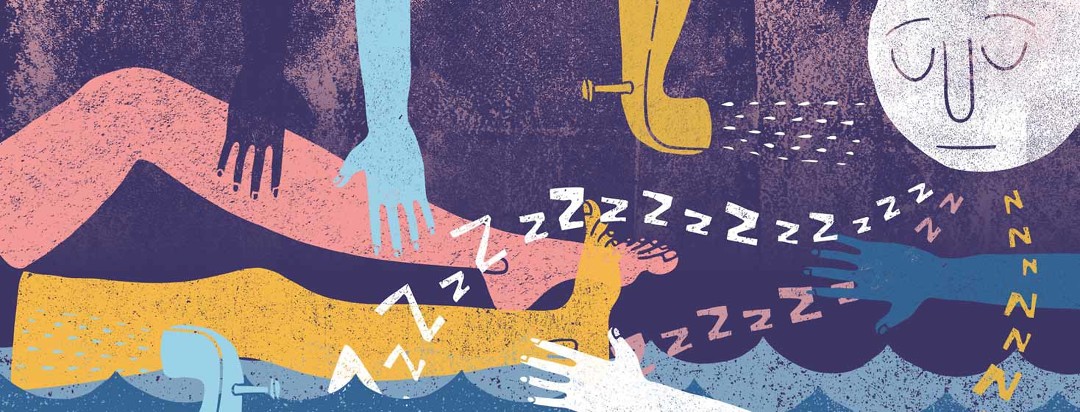Coping Tips for RLS at Work, Home, and Travel
Restless legs syndrome (RLS) can make certain times of the day as well as certain activities more challenging. It can be hard to think about sitting at a desk, going to a movie, or being stuck in an airplane or car for a long journey when your legs have a crawling, aching feeling and do not like to sit still.
While there is no cure for RLS, there are ways of managing the symptoms. You can find workarounds that allow you to continue doing things you enjoy!
Coping in the workplace
For those who work in an office or any job that requires a lot of sitting, RLS can feel particularly overwhelming. The best way to begin is by having conversations with your boss, human resources, and co-workers to explain your medical situation. Have a note from your doctor as well.
Request a standing desk or a sit/stand workstation, which allows you to adjust depending on what you need throughout the day. If people are informed of why you need to get up to stand/stretch/move during the day there is less possibility for misunderstandings to occur that can affect those professional relationships.1-3
Coping at home
Evenings and nighttime are often the most difficult times of the day for RLS. One key practice is distraction! Find activities you enjoy that can occupy your mind and distract you from your legs. You might enjoy word or logical puzzles, knitting or crocheting, reading a book, watching a movie or TV show, playing card or board games, writing, or having a conversation with friends or loved ones. Anything that keeps your mind engaged, particularly in the evening when symptoms can begin to flare, can be helpful.1-4
Get good sleep
Easier said than done with RLS! However, keeping a consistent bedtime and waking time can help. Many find keeping the room dark and cool can provide an environment for getting your best rest. Power down electronics an hour or two before bed and keep them out of the bedroom as these can stimulate the brain, making sleep more difficult. Speak with your doctor about doing a sleep study to check for sleep apnea as this can often worsen RLS symptoms.1-4
Exercise
Keep yourself moving! Getting some regular exercise, particularly exercise that targets the feet and legs can be helpful for RLS. Many find it best to exercise in the morning or over the lunch hour instead of in the evening. Evening workouts can exacerbate the symptoms and make it harder to sleep. Keeping the exercise light to moderate and not strenuous also reduces the risk for accidentally flaring your symptoms.1-4
Stretching
Doing some light stretching before bed can help to calm your legs and allow you to achieve better rest. Stretches or yoga poses that focus in particular on the legs, hips, calves, and feet can help you prepare to sleep.1-4
Alcohol and caffeine
One recommendation is to minimize the use of alcohol and caffeine. Alcohol is known to worsen symptoms and also can disrupt sleep, so eliminating or reducing to every once in a while is a good practice for helping to manage RLS. Caffeine affects people differently. For some, it is a trigger that worsens symptoms and for others, some caffeine can help to manage the symptoms. Start out by eliminating caffeine and then see how your symptoms respond.1-4
Alternative practices
It is also possible to find some relief for symptoms with techniques meant to help you relax. Some find temperature differences provide relief. While some people prefer hot baths and heating pads, others find cool showers and ice packs to offer more relief. Topical creams can also be useful for soothing achy legs. Discovering what, if any, particular product you enjoy is something you can test out. Applying pressure to the legs by wrapping them or putting blankets on top of them can be helpful for some people. Massage is another practice that some find helpful. This is best done late in the day or just before bed for the maximum benefit to help with calming the legs before sleep.1-4
Coping while traveling
The prospect of travel can feel daunting with RLS. Being in a confined space with limited ability to move is certainly a concern! However, there are ways to make it easier. Before traveling, avoid your triggers and do some stretching. As much as possible, maintain your bedtime and waking routine while traveling.
When flying, schedule a flight for early in the day when RLS symptoms tend to be at their best. Book an aisle, emergency exit, or bulkhead seat if possible. Speak to the flight attendant at boarding about your RLS and ask about places for you to stand out of the way when the “fasten seatbelt” sign is off. Bring things to keep your mind engaged, like snacks, books, or logic puzzles as well as any treatments like ice packs, medications, or extra water.
When taking a car trip, plan to start out early in the morning and allow yourself frequent stops to stretch your legs and walk around. Build in extra time if you have a strict arrival time for making those stops.1,5

Join the conversation